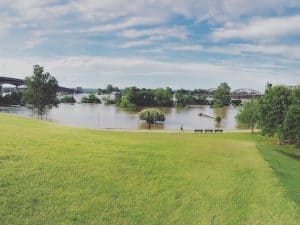calsfoundation@cals.org
Saving Our Community Memories
Arkansas River Flood of 2019

For some people, the Arkansas River Flood of 2019 brought immediate destruction: waterlogged homes, submerged vehicles, ruined farm crops. Even for those who suffered no losses, the flood was a shocking daily reminder of the unstoppable power of nature as waters crested in Little Rock at over 29 feet, more than 6 feet above flood stage.
For the archivists and staff at the CALS Roberts Library, the flood was a call to action.
Weather-predictive technology triggered warnings of impending historic flooding in late May, well before the levees were breached. Staff member Danielle Butler realized at that point that people in our region would be documenting the flood with photographs and videos. CALS archival staff would have a unique opportunity to preserve community history in the making by creating a collection of those community viewpoints.
“We felt like we really needed to get on it immediately,” Butler said, “because after this stuff gets off people’s news feeds, they’re going to clean out their camera rolls and it’s gone forever.”

Over 600 community submissions received
CALS staff set up a Google form and began to send out calls to the community asking for their flood footage and photos. “We wanted to create ways to make it personal,” Butler said, describing how people can add notes to their photos to explain the locations and circumstances behind each image. “We asked for all kinds of things, from weird animals that walked up on your lawn to actual flood damage, interiors, and exteriors. We wanted to see the flood from the perspective of the community, versus what news stations were capturing.”
Community members and local organizations have sent over 600 submissions thus far, including camera photos, social media posts, and aerial footage. The form is still open here for any remaining items that community members might wish to submit. Archived submissions are located here.
Chronicling historic flooding online
For the staff at the CALS Encyclopedia of Arkansas, the job was just beginning, but the flood also offered a rare example of how to chronicle history as soon as it unfolds.
 Encyclopedia Editor Guy Lancaster explained that his job requires him to collect daily regional newspapers for review, but he can’t always review them daily, and thus the papers can pile up. “By the time the flooding was reaching historic stages and it was an event that I knew we would want an entry on, I had a big stack of newspapers,” Lancaster said. “When I started going through them in chronological order, I realized “I’ve got the beginning of the event right here—I may as well just hammer out a few lines at a time and slowly piece an article together. Then I saved all the articles to make it easier for fact checking. We’ve continued to tinker with the entry as new data emerges, like the cost of the flooding, for example.”
Encyclopedia Editor Guy Lancaster explained that his job requires him to collect daily regional newspapers for review, but he can’t always review them daily, and thus the papers can pile up. “By the time the flooding was reaching historic stages and it was an event that I knew we would want an entry on, I had a big stack of newspapers,” Lancaster said. “When I started going through them in chronological order, I realized “I’ve got the beginning of the event right here—I may as well just hammer out a few lines at a time and slowly piece an article together. Then I saved all the articles to make it easier for fact checking. We’ve continued to tinker with the entry as new data emerges, like the cost of the flooding, for example.”
The EOA entry, titled “Flood of 2019,” includes over 70 citations of newspaper stories of all kinds. The entry is a sterling example of chronicling, research and concise writing that could make a standalone example for any social studies or journalism teacher about how historians and journalists work together to preserve our cultural memory. Lancaster was impressed by the impact of the collective work of area journalists.
“I think the entry highlights the importance of journalism,” Lancaster said. “You can’t do history without good reports.”
(Featured top banner image: flooded home in Maumelle, photo by Tannar Moix)



